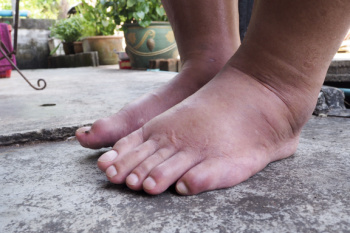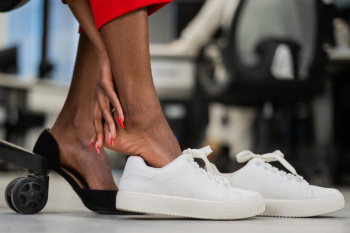Items filtered by date: September 2024
What Can Cause Toe Pain?

Toe pain can stem from various conditions with distinct characteristics. Osteoarthritis, a degenerative joint disease, can cause pain and stiffness in the toe joints as cartilage wears away over time. Gout, a form of arthritis caused by uric acid crystals, often affects the big toe leading to sudden and intense pain, redness, and swelling. Turf toe, an injury common in athletes, results from hyperextension of the big toe and can cause pain and swelling at the base of the toe. Additionally, fractures, or broken toes, may occur from trauma or excessive stress, resulting in sharp pain, bruising, and difficulty moving the toe. If you have developed toe pain, it is suggested that you consult a podiatrist who can accurately diagnose the cause and provide the appropriate treatment solutions.
Toe pain can disrupt your daily activities. If you have any concerns, contact our podiatrists of CNY Foot Surgery & Podiatry Care. Our doctors can provide the care you need to keep you pain-free and on your feet.
What Causes Toe Pain?
Most severe toe pain is caused due to a sports injury, trauma from dropping something heavy on the toe, or bumping into something rigid. Other problems can develop over time for various reasons.
Toe pain can be caused by one or more ailments. The most common include:
- Trauma
- Sports injury
- Wearing shoes that are too tight
- Arthritis
- Gout
- Corns and calluses
- Hammertoe
- Bunions
- Blisters
- Ingrown toenails
- Sprains
- Fractures (broken bones)
- Dislocations
When to See a Podiatrist
- Severe pain
- Persistent pain that lasts more than a week
- Signs of infection
- Continued swelling
- Pain that prevents walking
Diagnosis
In many cases the cause of toe pain is obvious, but in others, a podiatrist may want to use more advanced methods to determine the problem. These can range from simple visual inspections and sensation tests to X-rays and MRI scans. Prior medical history, family medical history, and any recent physical traumatic events will all be taken into consideration for a proper diagnosis.
Treatment
Treatments for toe pain and injuries vary and may include shoe inserts, padding, taping, medicines, injections, and in some cases, surgery. If you believe that you have broken a toe, please see a podiatrist as soon as possible.
If you have any questions please feel free to contact our office located in East Syracuse, NY . We offer the newest diagnostic tools and technology to treat your foot and ankle needs.
Common Causes of Foot and Ankle Swelling

Foot and ankle swelling can result from various underlying conditions and injuries. Traumatic injuries, such as sprains, fractures, or bruising, often lead to localized swelling due to inflammation and fluid accumulation. Gout, a type of arthritis caused by the buildup of uric acid crystals in the joints, can cause sudden and severe swelling, typically accompanied by intense pain. Arthritis, including osteoarthritis and rheumatoid arthritis, can lead to chronic swelling and stiffness in the feet and ankles as the joint tissues become inflamed. Infections, whether from cuts, bites, or systemic illnesses, can also cause swelling as the body responds to the invading pathogens. If you notice your feet and ankles have become swollen, it is suggested that you consult a podiatrist who can determine the cause and guide you toward effective relief and treatment solutions.
Swollen feet can be a sign of an underlying condition. If you have any concerns, contact our podiatrists of CNY Foot Surgery & Podiatry Care. Our doctors can provide the care you need to keep you pain-free and on your feet.
Swollen feet are a common ailment among pregnant women and people who stand or sit for extended periods. Aging may increase the possibility of swollen feet and patients who are obese often notice when their feet are swelling too. There may be medical reasons why swollen feet occur:
- Phlebitis - A condition that causes the veins to become inflamed and can also cause leg pain.
- Liver disease - This may lead to low blood levels of albumin which is a protein. This can cause fluid in the blood to pass into the tissues and several areas of the body can become swollen.
- Heart failure - When the heart doesn’t pump properly the blood that is normally pumped back to the heart can pool in the veins of the legs causing swollen feet.
- Kidney disease - One of the main functions of the kidneys is releasing excess fluid in the body. This type of condition can make it difficult for the kidneys to function properly, and as a result the feet may become swollen.
- Deep-vein thrombosis (DVT)- This is a serious condition where blood clots form in the veins of the legs. They can block the return of blood from the legs to the heart which may cause the feet to swell. It is important to be treated by a podiatrist if this condition is present.
Swollen feet can also be caused by bone and tendon conditions, including fractures, arthritis, and tendinitis. Additionally, there may be skin and toenail conditions and an infection may cause the feet to swell. Patients who take medicine to treat high blood pressure may be prone to getting swollen feet.
Many patients elevate their feet to help relieve the swelling and this is generally a temporary remedy. When a podiatrist is consulted the reason behind the swelling can be uncovered and subsequently treated.
If you have any questions please feel free to contact our office located in East Syracuse, NY . We offer the newest diagnostic tools and technology to treat your foot and ankle needs.
Reminder: When Was the Last Time...?
Plantar Heel Pain

Plantar heel pain, commonly associated with plantar fasciitis, is characterized by sharp, stabbing pain at the bottom of the heel. It is especially noticeable with the first steps in the morning or after prolonged periods of sitting. This discomfort arises from inflammation of the plantar fascia, a thick band of tissue connecting the heel to the toes. Symptoms typically include a deep ache or a burning sensation in the heel, which may worsen with activity or after standing for long periods. Contributing factors include overuse, poor foot mechanics, and inadequate footwear. Effective treatment often involves rest and stretching exercises for the Achilles tendon and plantar fascia. Wearing supportive shoes with adequate cushioning and using orthotic inserts can also provide relief. In persistent cases, specialized exercises or corticosteroid injections may be considered. For a tailored treatment plan for plantar fasciitis, it is suggested you make an appointment with a podiatrist.
Plantar fasciitis is a common foot condition that is often caused by a strain injury. If you are experiencing heel pain or symptoms of plantar fasciitis, contact our podiatrists from CNY Foot Surgery & Podiatry Care. Our doctors can provide the care you need to keep you pain-free and on your feet.
What Is Plantar Fasciitis?
Plantar fasciitis is one of the most common causes of heel pain. The plantar fascia is a ligament that connects your heel to the front of your foot. When this ligament becomes inflamed, plantar fasciitis is the result. If you have plantar fasciitis you will have a stabbing pain that usually occurs with your first steps in the morning. As the day progresses and you walk around more, this pain will start to disappear, but it will return after long periods of standing or sitting.
What Causes Plantar Fasciitis?
- Excessive running
- Having high arches in your feet
- Other foot issues such as flat feet
- Pregnancy (due to the sudden weight gain)
- Being on your feet very often
There are some risk factors that may make you more likely to develop plantar fasciitis compared to others. The condition most commonly affects adults between the ages of 40 and 60. It also tends to affect people who are obese because the extra pounds result in extra stress being placed on the plantar fascia.
Prevention
- Take good care of your feet – Wear shoes that have good arch support and heel cushioning.
- Maintain a healthy weight
- If you are a runner, alternate running with other sports that won’t cause heel pain
There are a variety of treatment options available for plantar fasciitis along with the pain that accompanies it. Additionally, physical therapy is a very important component in the treatment process. It is important that you meet with your podiatrist to determine which treatment option is best for you.
If you have any questions, please feel free to contact our office located in East Syracuse, NY . We offer the newest diagnostic and treatment technologies for all your foot care needs.
Exercises for Building Arches in Flat Feet

Flat feet can lead to discomfort and other issues, but targeted exercises can help to build arch strength and improve flexibility. One beneficial exercise is the toe raise, where you stand with your feet flat and then slowly lift your heels off the ground while keeping your toes and the balls of your feet planted. This movement strengthens the muscles that support the arch. To enhance flexibility, incorporate stretches like the towel stretch, where you sit with your legs extended and use a towel to gently pull your toes towards you, stretching the calf muscles and Achilles tendon. Another effective stretch involves rolling your foot over a small ball or rolling pin to target the plantar fascia. Regularly performing these exercises can improve arch support and overall foot health. If you have flat feet and you are uncomfortable, it is suggested that you confer with a podiatrist who can help you to manage this condition.
Flatfoot is a condition many people suffer from. If you have flat feet, contact our podiatrists from CNY Foot Surgery & Podiatry Care. Our doctors will treat your foot and ankle needs.
What Are Flat Feet?
Flatfoot is a condition in which the arch of the foot is depressed and the sole of the foot is almost completely in contact with the ground. About 20-30% of the population generally has flat feet because their arches never formed during growth.
Conditions & Problems:
Having flat feet makes it difficult to run or walk because of the stress placed on the ankles.
Alignment – The general alignment of your legs can be disrupted, because the ankles move inward which can cause major discomfort.
Knees – If you have complications with your knees, flat feet can be a contributor to arthritis in that area.
Symptoms
- Pain around the heel or arch area
- Trouble standing on the tip toe
- Swelling around the inside of the ankle
- Flat look to one or both feet
- Having your shoes feel uneven when worn
Treatment
If you are experiencing pain and stress on the foot you may weaken the posterior tibial tendon, which runs around the inside of the ankle.
If you have any questions please feel free to contact our office located in East Syracuse, NY . We offer the newest diagnostic and treatment technologies for all your foot and ankle needs.




